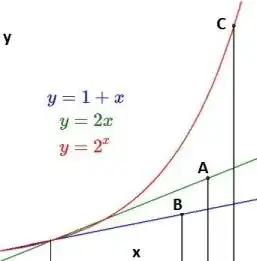Alternative and relatively easy solution without using logarithms. Let us set
$$h=2^{4^{2^4}}$$
$$j=4^{2^{4^2}}$$
$$k=2^{2^{2^{.^{.^{.^{2^{2}}}}}}}$$
where $h $ and $j $ only contain four numbers (two $2$ and two $4$), and $k $ contains sixteen $2$. Calculating the exponential towers starting from the top, we have
$$h=2^{4^{16}} = 2^{2^{32}} $$
$$j=4^{2^{16}} = 2^{2 \cdot 2^{16}} = 2^{ 2^{17}} $$
so that $h>j $ . Also, considering $k $ and solving its first two exponentials from the top, we get an exponential tower formed by fourteen elements where the first thirteen are $2$ and the last one is $16$. Therefore we clearly have $k>h>j$.
Now let us consider the numbers $A , B , C $ reported in the OP. Again starting to solve the exponentials from the top, we can rewrite them as
$$A=(A_1)^h $$
$$B=(B_1)^j $$
$$C=(C_1)^k $$
where $A_1$ and $B_1 $ are exponential towers similar to the initial towers $A $ and $B $, respectively, but with $500-4=496 \,\,\, $ elements instead of $500$; and where $C_1$ is an exponential tower similar to the initial $C $ but with $2000-16=1984 \,\,\, $ elements instead of $2000$.
Because $k>h>j \,\,\, $, if we could show that $C_1>A_1>B_1 \,\,\, $, then this would necessarily imply $C>A>B \,\,\, $. With this in mind, we can now repeat the same procedure above, applying it to $A_1, B_1, C_1 \,\,\, $. So we can set
$$A_1=(A_2)^h $$
$$B_1=(B_2)^j $$
$$C_1=(C_2)^k $$
where $A_2$ and $B_2 $ are again exponential towers similar to $A $ and $B$, respectively, but with $500-2\cdot 4 =492 \,\,\, $ elements instead of $500$; and where $C_2$ is an exponential tower similar to $C $ but with $2000-2 \cdot 16=1968 \,\,\, $ elements instead of $2000$. As above, because $k>h>j \,\,\, $, if we could show that $C_2>A_2>B_2$, then this would necessarily imply $C_1>A_1>B_1 \,\,\, $, and then $C>A>B \,\,\, $.
To generalize, after repeating this procedure $m $ times, we obtain two numbers $A_m$ and $B_m $ that are exponential towers similar to $A $ and $B $, respectively, but with $500-m\cdot 4 \,\,\,$ elements instead of $500$, and a third number $C_m$ that is an exponential tower similar to $C $ but with $2000-m \cdot 16 \,\,\, $ elements instead of $2000$. As above, because $k>h>j \,\,\, $, showing that $C_m>A_m>B_m \,\,\, \,\, $ necessarily implies $C_{m-1}>A_{m-1}>B_{m-1} \,\, \,\,\, $, which in turn implies $C_{m-2}>A_{m-2}>B_{m-2} \,\,\, \,\, $ and so on, until $C>A>B \,\,\, \,\, $.
So, repeating this procedure $m=124 \,\,$ times, we arrive to a point where $A_{124} $ and $B_{124} $ are exponential towers with $500-124\cdot 4 =4 \,\,\, $ elements, and $C_{124}$ is an exponential tower with $2000-124 \cdot 16=16 \,\,\, $ elements. Since $ A_{124}=h \,\, \,\,\, $, $B_{124}=j \,\, \,\,\, $, and $C_{124}=k \,\, \,\,\, $, we have $ C_{124}>A_{124}>B_{124} \,\,\, $, which necessarily implies, as shown above, $C>A>B \,\,\, $.
